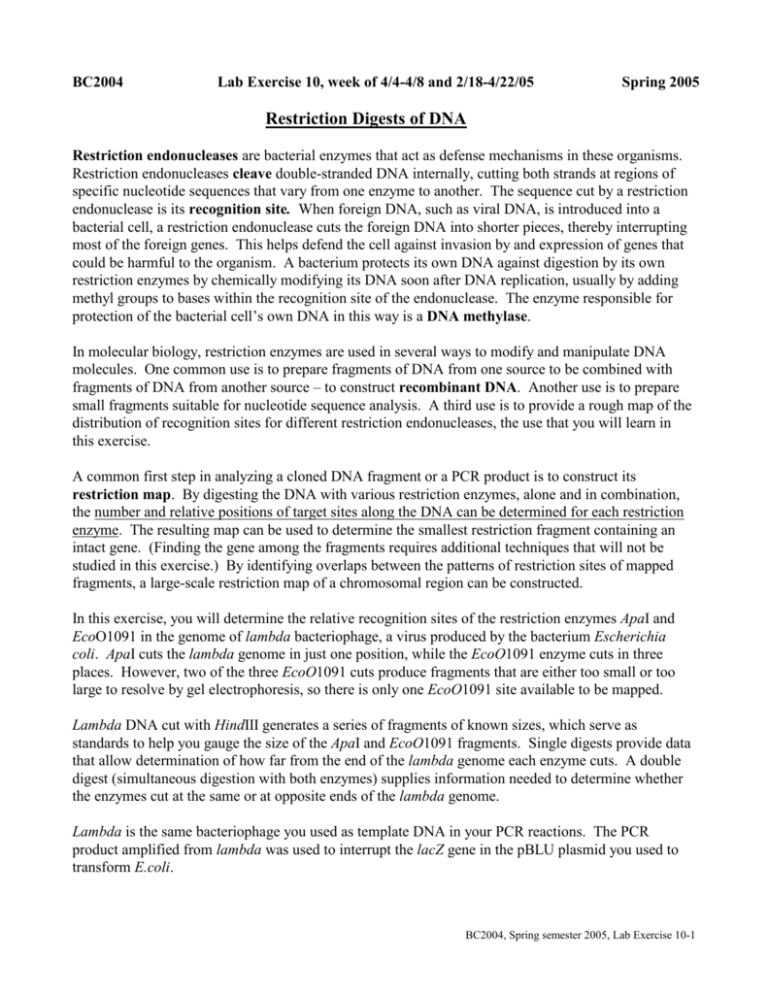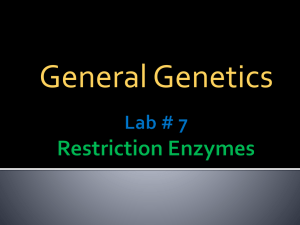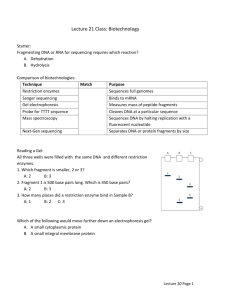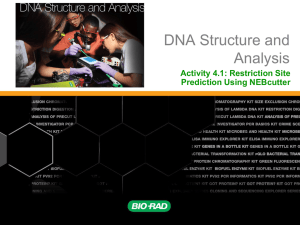Restriction Digest of DNA
advertisement

BC2004 Lab Exercise 10, week of 4/4-4/8 and 2/18-4/22/05 Spring 2005 Restriction Digests of DNA Restriction endonucleases are bacterial enzymes that act as defense mechanisms in these organisms. Restriction endonucleases cleave double-stranded DNA internally, cutting both strands at regions of specific nucleotide sequences that vary from one enzyme to another. The sequence cut by a restriction endonuclease is its recognition site. When foreign DNA, such as viral DNA, is introduced into a bacterial cell, a restriction endonuclease cuts the foreign DNA into shorter pieces, thereby interrupting most of the foreign genes. This helps defend the cell against invasion by and expression of genes that could be harmful to the organism. A bacterium protects its own DNA against digestion by its own restriction enzymes by chemically modifying its DNA soon after DNA replication, usually by adding methyl groups to bases within the recognition site of the endonuclease. The enzyme responsible for protection of the bacterial cell’s own DNA in this way is a DNA methylase. In molecular biology, restriction enzymes are used in several ways to modify and manipulate DNA molecules. One common use is to prepare fragments of DNA from one source to be combined with fragments of DNA from another source – to construct recombinant DNA. Another use is to prepare small fragments suitable for nucleotide sequence analysis. A third use is to provide a rough map of the distribution of recognition sites for different restriction endonucleases, the use that you will learn in this exercise. A common first step in analyzing a cloned DNA fragment or a PCR product is to construct its restriction map. By digesting the DNA with various restriction enzymes, alone and in combination, the number and relative positions of target sites along the DNA can be determined for each restriction enzyme. The resulting map can be used to determine the smallest restriction fragment containing an intact gene. (Finding the gene among the fragments requires additional techniques that will not be studied in this exercise.) By identifying overlaps between the patterns of restriction sites of mapped fragments, a large-scale restriction map of a chromosomal region can be constructed. In this exercise, you will determine the relative recognition sites of the restriction enzymes ApaI and EcoO1091 in the genome of lambda bacteriophage, a virus produced by the bacterium Escherichia coli. ApaI cuts the lambda genome in just one position, while the EcoO1091 enzyme cuts in three places. However, two of the three EcoO1091 cuts produce fragments that are either too small or too large to resolve by gel electrophoresis, so there is only one EcoO1091 site available to be mapped. Lambda DNA cut with HindIII generates a series of fragments of known sizes, which serve as standards to help you gauge the size of the ApaI and EcoO1091 fragments. Single digests provide data that allow determination of how far from the end of the lambda genome each enzyme cuts. A double digest (simultaneous digestion with both enzymes) supplies information needed to determine whether the enzymes cut at the same or at opposite ends of the lambda genome. Lambda is the same bacteriophage you used as template DNA in your PCR reactions. The PCR product amplified from lambda was used to interrupt the lacZ gene in the pBLU plasmid you used to transform E.coli. BC2004, Spring semester 2005, Lab Exercise 10-1 Procedure (work in pairs) 1. Practice pipetting 1.0-μl volumes. This will be somewhat challenging to do accurately. Be sure you know what 1.0 μl should look like in the pipette tip and then be sure to check visually that you have this amount during step 3. 2. Label three sterile 0.5-ml tubes, in which you will perform your restriction digests: “A” for ApaI “E” for EcoO1091 “A/E” for ApaI + EcoO1091. 3. Use the table below as a checklist while adding reagents to each reaction tube. Add components from left to right in the table. Read down each column, adding the same reagent to all appropriate tubes and using a fresh tip for each reagent. All groups will share the same container of each enzyme. The enzymes are in a glycerol solution that is quite viscous. It is important that you place only the very TIP of the pipette tip into the enzyme solutions. If you put the whole tip into the tube, you will have much more enzyme on the outside of your tip than on the inside. In addition, having too much glycerol in the reactions will inhibit the activity of the restriction enzymes. Tube water buffer DNA ApaI EcoO1091 “A” 9 μl 2 μl 8 μl 1 μl — “E” 9 μl 2 μl 8 μl — 1 μl “A/E” 8 μl 2 μl 8 μl 1 μl 1 μl 4. Collect and mix the reagents by tapping the tube bottom on the lab bench. 5. Incubate all reaction tubes for a minimum of 60 min** at 37o C. This will be your stopping point for today’s lab period. The digests will be stored for analysis by gel electrophoresis in Exercise 11. ** During this one-hour incubation period, you should complete lab exercise 8 by collecting and analyzying your bacterial transformation data. BC2004, Spring semester 2005, Lab Exercise 10-2 Materials per PAIR of students: (extras should be available) 3 0.5-mL sterile Eppendorf tubes 1 Sharpie pen 1 aliquot of Lambda DNA, 30 uL 1 tube of sterile, distilled water, 40 uL 1 tube of 10X restriction buffer, 10 uL 1 micropippettor 0.5 – 10 uL 1 box sterile micropipette tips per group of EIGHT students: 1 ice bucket containing tubes of Apa I and EcoO1091 restriction enzymes 37-degree C incubator for one-hour incubation BC2004, Spring semester 2005, Lab Exercise 10-3






